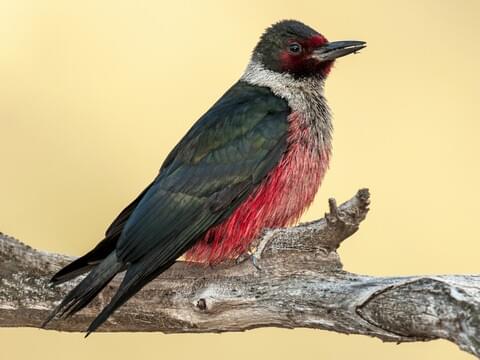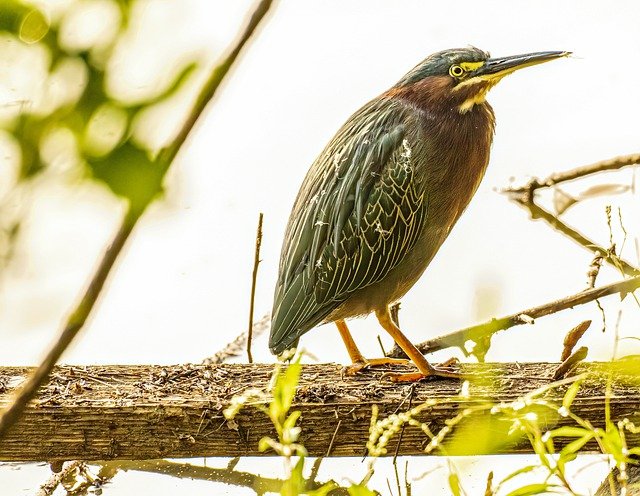In this article I’ll be going over 5 unique green birds that can be found throughout Nevada so, continue reading for a more detailed look at each bird below.
- Violet Green Swallow
- Lewis’s Woodpecker
- Green Heron
- Mallard
- Ruby Crowned Kinglet
5 Green Birds In Nevada
1. Violet Green Swallow (Tachycineta Thalassina)

- Size: 13 – 14cm
- Weight: 13 – 15 grams
- Wingspan: 26 – 28cm
Violet green swallows tend to spend their spring and summer breeding months all throughout Nevada.
These swallows are recognised by their darker green upper back and upper head, graysish/green wings and tail feathers along with a white face and breast. Females look very similar to the males.
Violet green swallows can be found around deciduous and coniferous forest where you’ll see them nesting within tree holes.
These swallows feed on a variety flying insects like flies, true bugs, wasps, winged ants, wild bees, beetles, moths etc. like most others. They will also eat the occasional berry or seed if they come across some.
The oldest recorded violet green swallow lived for 9 years and 1 month but, the typical lifespan for these birds will be at least a couple years less.
2. Lewis’s Woodpecker (Melanerpes Lewis)

- Size: 25 – 28cm
- Weight: 110 – 130 grams
- Wingspan: 49 – 52cm
You’ll find Lewis’s woodpeckers in southern Nevada in their non-breeding season and in the remainder of the state on a year round basis.
Lewis’s woodpecker is recognised by their red, black and dark green plumage where their wings and back are black in color, their breast and face have elements of red and their neck a mostly white/gray color. Females are mostly white and gray,
These woodpeckers can be found in open ponderosa pine forests and burned forests with a high density of standing dead trees. They will also breed near streamsides, oak woodlands, orchards, and pinyon-juniper woodlands.
Lewis’s woodpeckers mostly eat insects that they catch flying in mid-air or found on branches and trees, nuts along with a variety of seeds.
As for how long these woodpeckers are known to live for, it can be anywhere from 4 – 12 years.
3. Green Heron (Butorides Virescens)

- Size: 40 – 44cm
- Weight: 230 – 250 grams
- Wingspan: 54 – 58cm
You’ll find green herons in southern Nevada on year round basis and slightly above these regions when breeding.
These heron’s are recognised by their darker green back and wings, maroon chest and neck, with yellow legs and a relatively long and pointy black beak. Females on the other hand are mostly brown and gray in color.
Green herons tend to spend the majority of their time around wetlands like lakes, ponds, marshes, swamps, streamsides and rivers.
As for what they consume, it includes a variety of different sources such as small fish like minnows, sunfishes, gizzard shads, crustaceans, aquatic insects, frogs, tadpoles, grasshoppers, snakes, earthworms, snails and other smaller rodents.
Green herons don’t have the longest of lifespans for a bird of their size, with the maximum known life expectancy said to be around 8 years.
4. Mallard (Anas Platyrhynchos)

- Size: 50 – 65cm
- Weight: 0.72 – 1.6kg
- Wingspan: 81 – 98cm
Mallards can be spotted in Nevada all throughout the year, specifically around ponds and lakes.
You’ll be able to recognise mallards by their dark, iridescent green head, brown neck, brown stripes upon the upper level of the wing with the remainder of their body a cream/white color. Females on the other hand are a mostly light brown patterned color with both male and females having orange webbed feets.
Mallards prefer calm, shallow sanctuaries, but can be found in almost any body of freshwater, which can include wetlands, saltwater and brackish water.
These ducks tend mostly to consume seeds, acorns and berries, plants, insects and shellfish.
In regards to lifespan, these mallards are known to live for around 5 – 10 years in the wild.
5. Ruby Crowned Kinglet (Regulus Calendula)

- Size: 9 – 11cm
- Weight: 5 – 10 grams
- Wingspan: 16 – 18cm
Ruby crowned kinglets are year round residents in the northern region of Nevada but, will be in the remainder of the state throughout their fall and winter non-breeding months.
These kinglets are recognised by their gray and green plumage throughout, besides the red/orange color on the top of their head. Females look almost the same bar the orange/red element on the head.
Ruby crowned kinglets will often be found by tall, dense conifer forests such as spruce, fir, and tamarack.
These kinglets eat the same food sources as most other birds in the wild, which in this case would be small insects, small berries, seeds and other smaller fruits.
As for how long a ring crowned kinglet can live for, it’s estimated to be around 4 – 6 years.
Amhil Khan, a dedicated nature enthusiast and the founder of BirdsOfTheWild.com, is a passionate advocate for the captivating world of avian wonders. With a deep-seated curiosity about the intricate lives of birds, Amhil’s journey began as a fascination and has evolved into a mission to inspire others to appreciate and protect these magnificent creatures.
Amhil’s love for birds led to the creation of Birds of the Wild, a platform where his expertise in ornithology, coupled with his captivating storytelling, provides readers with an immersive and educational experience. Through his lens and words, he captures the essence of birds in their natural habitats, offering a glimpse into their behaviors, migrations, and the ecosystems they inhabit.

